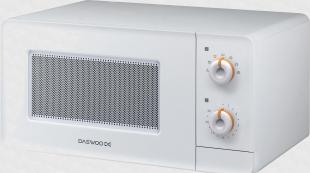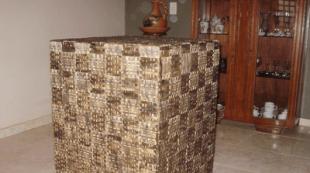Which slightly offload those power grids. Basic terms and concepts in electrical engineering. The main causes of power overload
The number of electrical appliances used in houses or apartments is increasing every year, thereby increasing the load on the household network. In most residential premises, wiring was carried out 20-30 years ago, when the allowable loads were considered according to completely different standards. Accordingly, when powerful consumers of electricity are connected, an overload of the electrical network occurs. Its nature and consequences will be discussed in this article.
What is overload?
First of all, it is necessary to define the terminology, that is, to find out what is meant by overload. With regard to electrical networks, it is customary to call them an emergency (emergency) mode of operation, in which the passing current exceeds the allowable (calculated) value.
The main causes of power overload
Before considering ways to protect the home electrical network from overload, it is necessary to establish the cause of its occurrence. Otherwise, the measures taken may be ineffective. As practice shows, most often the abnormal operation of the local section of the circuit can be caused by the following reasons:
- Connection to the mains of faulty household electrical appliances.
- Incorrect load distribution between the lines of the electrical network.
- Wiring problems (untimely replacement, incorrect installation, errors in, incorrect selection of the rating of circuit breakers, etc.).
- Exceeding the power of lighting groups.
- Poor quality of power supply.
Let's take a closer look at each of the above reasons.
Plugging in a faulty electrical appliance
It is strictly contraindicated to connect faulty household appliances to the network. This can lead to a short circuit and trip the electromagnetic release of the circuit breaker. It may well happen that faulty electrical engineering does not cause a short circuit, but begins to consume significantly more than the allowable current. In such a situation, the thermal protection AB is activated.
In both the first and second cases, there is an overload of the electrical wiring, therefore, at the first sign of a malfunction of household electrical appliances, they must be disconnected from the network and taken to a repair shop. Remember that faulty devices can cause a fire.
Wrong load distribution
This is the most common reason electrical wiring is overloaded, so it makes sense to give an illustrative example.
Suppose there is a certain electric point in the apartment, to which a washing machine and a boiler are connected simultaneously through a “tee”, with a capacity of 2.3 and 2.6 kW, respectively. From this it follows that the total power of electrical appliances will be 4.9 kW. This means that the current load on the line will be slightly more than 22 A (I \u003d P / U \u003d 4900/220 \u003d 22.27).
Since the rated current of the circuit breakers in the electrical panels of most apartments is 10 or 16 A, when these household appliances are turned on at the same time, thermal protection will trip due to an overload.
To get out of this situation, many make a classic mistake that can be fatal. Namely, they install an automatic machine on the line, designed for high electrical power, for example, 25 or 32 Amperes. Considering that in most houses of the secondary housing market, a cable with a rated current of 19 A was used, the wires will heat up, followed by a violation of the insulation of the conductors.
In addition, it should be borne in mind that typical electrical sockets are manufactured for a rated current of 16.0 Amperes. Exceeding it by almost 40% will lead to the fact that the body of the electric point will melt.
The likelihood of a fire due to such an ill-conceived distribution of the load is quite high. The situation can be significantly aggravated by using tees or extension cords from Chinese manufacturers.
The correct solution to eliminate overload in the above example would be to lay separate power lines for each powerful electrical appliance.
Untimely replacement of wiring
The service life of the electrical network is a rather important factor that should not be ignored when talking about the causes of overload. It is believed that its duration directly depends on the material from which the electric cable is made. This is partly true, but it is more reasonable to be guided by the Departmental building codes, in particular VSN 58 88, which are still in force today.
In accordance with this regulatory document, the service life of intra-apartment household networks of residential premises is 40 years for hidden wiring and 25 years for external wiring. At the same time, for network elements (sockets, switches, etc.), this period is limited to 10 years.
For aluminum wires used for wiring in the era of mass building of the last century, the service life is limited to 30 years. Recall that since 2001, it is forbidden to use wires with aluminum conductors for wiring. If you got an apartment with such wiring, we strongly advise you to replace it without delay.
But it was we who gave the normative terms, the actual ones can differ significantly, both up and down. An important influence on this is the heating of the cable, caused by an overload of the electrical network. Exceeding the temperature by only 5 ° C above the permissible norm reduces the life of the wiring by half.
Let's take a reverse example. Let's say the cross section of the wiring cable is 2.50 mm, which allows a passing current of up to 25 A. If you install an automatic fuse with a rated current of 16 A on it, then the actual life of the wiring may exceed the standard, and the risk of overloads will be practically eliminated. Therefore, it is important to choose the correct cross-section of wires and the rated current of circuit breakers, in order to simplify your task, you can use the table shown in the figure.

Exceeding the power of lighting groups
Installing a large number of energy-intensive lighting fixtures can provoke an overload. But nowadays, the availability of energy-saving and LED lamps has almost eliminated this problem.
Poor quality of power supply
An overload of the network can be provoked by a settled under or over voltage, which is also dangerous for your devices. Since the quality of the power supply is an external factor, this cause can only be dealt with by installing protection. As such, a stabilizer and / or voltage relay is used.

Possible consequences
Even a slight overload of the household electrical network can create many problems and lead to serious consequences. We list them so that you understand the seriousness of this problem:
- Heating the cable leads to damage to the insulation of the wires, which can provoke the occurrence of short circuits and, as a result, a fire.
- Frequent automatic shutdowns can cause loss of data on computer equipment and cause malfunction of electronic devices.
- A significant increase in current causes a voltage drop in the circuit section, which affects the operation of almost all electrical appliances.
This is not a complete list of consequences. As you can see, the most serious of them can lead to a fire. Moreover, as sad statistics show, during overloads, fires most often occur due to a short circuit, the consequences of which are much more serious than the loss of information due to turning off the machines.

How to prevent and eliminate power overloads?
Considering what unpleasant consequences occur if an overload occurs, we will tell you how to protect your electrical network. Since overload is a consequence, the causes that cause it must be eliminated. To do this, you must adhere to the following recommendations:
- Do not connect electrical devices, the performance of which is in doubt.
- Correctly distribute the load on the household electrical network.
- Be serious about the calculations and installation of electrical wiring. If you have no experience in electrical work, it is better to contact specialists. It is the problematic wiring that is the most common cause of a fire.
- If the quality of electricity is low, install a stabilizer and a voltage relay at the input.
The electrical network of a house or apartment, regardless of the quality and date of commissioning, is designed for a certain load. If they are exceeded, the most unpleasant consequences are possible:
- . failure of sockets, switches and electricity meters;
- . destruction or melting of insulation;
- . short circuit wiring;
- . fire.
The last moment is fraught with the greatest danger. To avoid this, you need to install voltage stabilizers, be aware of the possible causes of overload and avoid them.
Network overload due to the fault of an electrician
Inexperienced engineers and installers can miscalculate loads and choose wires with insufficient cross section. It is even worse if, through their fault, protective devices with an overestimated threshold are installed. In this case, the automation will not turn off the power supply even in the event of a short circuit, which guarantees the occurrence of a fire.
Problems can arise if powerful energy consumers are connected incorrectly: boilers, heaters, pumps, air conditioners. There is only one way to avoid this - by contacting highly qualified specialists with an established reputation.
Network overload due to the fault of the owners
Careless handling of wires and equipment, the use of inappropriate extension cords and electrical appliances often leads to overload. Therefore, only one powerful consumer should be connected to the outlet and an electrician of dubious quality should not be used.
Overloads under the influence of the elements
Even a powerful stabilizer can not withstand the consequences of a lightning strike in a power line. To protect the home network, you should use a ground loop made in accordance with electrical safety standards.
Remember, network congestion is easier to prevent than it is to deal with the consequences. The company "Electromontazh" is always ready to go to eliminate emergency and post-accident situations. Our specialists work for you around the clock.
An overload is a phenomenon when a current exceeds the allowable current through electrical wires and electrical appliances. The danger of overload is due to the thermal effect of the current. With a double or greater overload, the combustible insulation of the conductors ignites. With small overloads, the insulation rapidly ages and the life of its dielectric properties is reduced.
So, overloading wires by 25% reduces their service life to about 3-5 months instead of 20 years, and overloading by 50% renders wires unusable within a few hours.
The main reasons for overload are:
- discrepancy between the cross-section of conductors and the operating current (for example, when wiring to the bell is carried out by a telephone wire);
- parallel connection to the network of current collectors not provided for by the calculation without increasing the cross section of the conductors (for example, connecting an extension cord with 3-4 outlets to one working one);
- contact with conductors of leakage currents, lightning;
- increase in ambient temperature.
In addition, when the electrical network is overloaded, the devices and devices connected to it constantly experience a shortage of current, which can lead to their emergency failure. In this regard, pay attention to the passport data of electrical appliances: current and voltage. It is desirable that the supply voltage of electrical appliances deviate by the maximum allowable value from 220 V (for example, from 90 to 260 V).
A short circuit is any short circuit between wires, or between a wire and ground. The cause of a short circuit is a violation of the insulation in electrical wires and cables, which is caused by: overvoltages; insulation aging; mechanical damage to the insulation.
Transitional resistance is the resistance that occurs at the points of current transition from one wire to another or from a wire to any electrical device in the presence of poor contact at the joints and terminations (when twisting, for example). When current passes in such places, a large amount of heat is released per unit time. If heated contacts come into contact with combustible materials, then they may ignite, and in the presence of explosive mixtures, an explosion. This is the danger of the substation, which is aggravated by the fact that places with the presence of transient resistances are difficult to detect, and the protective devices of networks and installations, even correctly selected ones, cannot prevent the onset of a fire, since the electric current in the circuit does not increase, and the heating of the section with PS occurs only due to an increase in resistance.
Sparking and electric arc - the result of the passage of current through the air. Sparking is observed when electrical circuits are opened under load (for example, when an electrical plug is removed from an electrical outlet), when there is a breakdown of insulation between conductors, and also in all cases when there are poor contacts at the junctions and terminations of wires and cables. Under the action of an electric field, the air between the contacts is ionized and, with a sufficient voltage value, a discharge occurs, accompanied by air glow and crackling (glow discharge). With an increase in voltage, the glow discharge turns into a spark discharge, and with sufficient power, the spark discharge can be in the form of an electric arc. Sparks and electric arcs in the presence of combustible substances or explosive mixtures in the room can cause a fire and explosion.
Each power grid, regardless of its scale, is designed for certain loads. Almost everyone knows this, but at the same time, for some reason, they stubbornly continue to overload the power grid, which leads to disastrous consequences. Consider the danger of overloading the power grid using the example of a country house - they are very popular today. Network overload in a country house can occur not only through the fault of illiterate electricians or owners, but also electricity suppliers. Voltage drops in suburban electrical networks are a very common occurrence, so the first rule follows from here:
- Always Install Voltage Stabilizers
The stabilizer will protect against sudden voltage drops in any direction. The fact is that automatic machines will respond to an increase in voltage, but decreases are not always caught. If you contacted a company of professionals, then they will definitely perform all the work at the proper level, using the best equipment.
Overloads due to electricians
Also, overloads are possible due to the fault of inexperienced electricians. If they incorrectly calculated the planned loads, picked up wires with the wrong wire cross-section, incorrectly selected automatic shutdown protective devices, then be in trouble. Moreover, a generator stops in almost every country house. If it is connected incorrectly, a short circuit may occur when the standard power is turned on. Also, electricians can incorrectly connect power units - pumps, household appliances. In this case, the machine will work all the time, which will make the use of the equipment almost impossible. There is only one way to avoid this - by turning to real professionals, and hence the second rule:
- Always refer only to highly qualified specialists
Overloads due to the fault of the owners
Often, the owners themselves are to blame for overloading the power grid. They connect too much equipment to one supply branch, use extension cords with the wrong wire section, and do not take care of electrical equipment. The result is a short circuit or electrical overload. Hence the third rule and the fourth rule:
- Never connect more than one appliance to the same outlet
- Do not use extension cords of dubious quality without familiarizing yourself with their characteristics.
The danger of overloads is that they can cause a fire and damage expensive equipment. But there is another source of overload, from which no one is immune.
Spontaneous network congestion
We are talking about lightning strikes into power transmission lines. In this case, the stabilizer may completely fail, but the most dangerous thing will happen if the discharge is powerful enough to break into the internal circuit of the power grid. Often this causes electrical equipment to fail, but the worst thing is the residual electrostatic charge that can remain in the network or electrical appliances. Then touching them may result in electric shock. To avoid this, it is important to properly arrange the ground loop, which real professionals are capable of - experienced electricians of the site company.
With a metal conductor wire, under ideal operating conditions, it may be true that nothing will be done. However, in real conditions, the conductor is subject to oxidation, deterioration of contact and heating at the place of poor contact ... In addition, poor contacts are also formed due to loosening of the screw connections of the wires.
But with the insulation of wires - even more difficult. The aging of the insulation causes the wire to fail and can be accompanied by various troubles - from a short circuit to a fire.
What is the aging of electrical wiring insulation?
First of all, in reducing the elasticity and mechanical strength of its material. The insulation becomes brittle and brittle. A small impact is enough, and its integrity is violated. After that, an electrical breakdown of the insulation and a short circuit may occur. And despite the fact that earlier, mainly combustible materials were used as insulating materials, then in case of emergency heating of conductive conductors of wires and the presence of a fire hazardous environment, a fire occurs.
Causes of aging of electrical wiring insulation
One of the main causes of premature aging of insulation is thermal aging caused by an increase in the temperature of the conductor. Naturally, the wire heats up for a reason, but during overloads of the electrical network caused by a prolonged excess of the current allowed for a given section of the conductor. Moreover, the service life of the insulation with an increase in the temperature of the conductor from normal by only 8 degrees - decreases by 2 times!
Causes of electrical overload
There are several reasons for the occurrence of an overload of the electrical network and wiring, among which are:
- incorrect calculation of the conductor section;
Connection of additional consumers, the power of which exceeds the permissible design values;
Mechanical overloads on the shaft of electric motors of household electrical appliances;
Long-term deviations of the mains voltage from the nominal value.
Insufficient electrical power supplied to the internal electrical network.
How to avoid electrical overload?
If a mistake was made during the calculation or installation of the electrical wiring and the conductor cross-section is less than required, then the situation can be corrected only by completely replacing such wiring or laying new lines from the electrical panel to the most loaded sockets with a wire of the required cross-section.
The operation of additional energy-intensive consumers, the total consumed current of which exceeds the value of the current setting of the introductory circuit breaker, can only be carried out using automation devices, for example, the OEL-820 power grid load optimizer.
It is necessary to exclude the operation of motors with mechanical overload of the shaft. For example, put a strainer on the suction pipe of a submersible pump so that sand does not get into it, clean the vacuum cleaner bag from dust in time, do not overload the mixer, meat grinder, electric drill, etc.
If the voltage in the house is below or above normal, you need to use a voltage stabilizer. However, it should be borne in mind that when the input voltage is low, the stabilizer increases it at the output by increasing the current consumption, which can also lead to wiring overload.
In case of insufficient allocated or supplied power, the missing kilowatts should be purchased from power engineers by making appropriate changes to the contract and project.
The most budgetary and easiest solution is a “virtual” increase in power grid capacity without purchasing additional power. Those. application of a device for limiting power consumption by controlling a non-priority load. For domestic use, the OEL-820 power grid load optimizer is best suited. This is the only household appliance on the market designed to effectively reduce power consumption and connect without the help of a specialist. Plugged it in and forgot about the problem!









